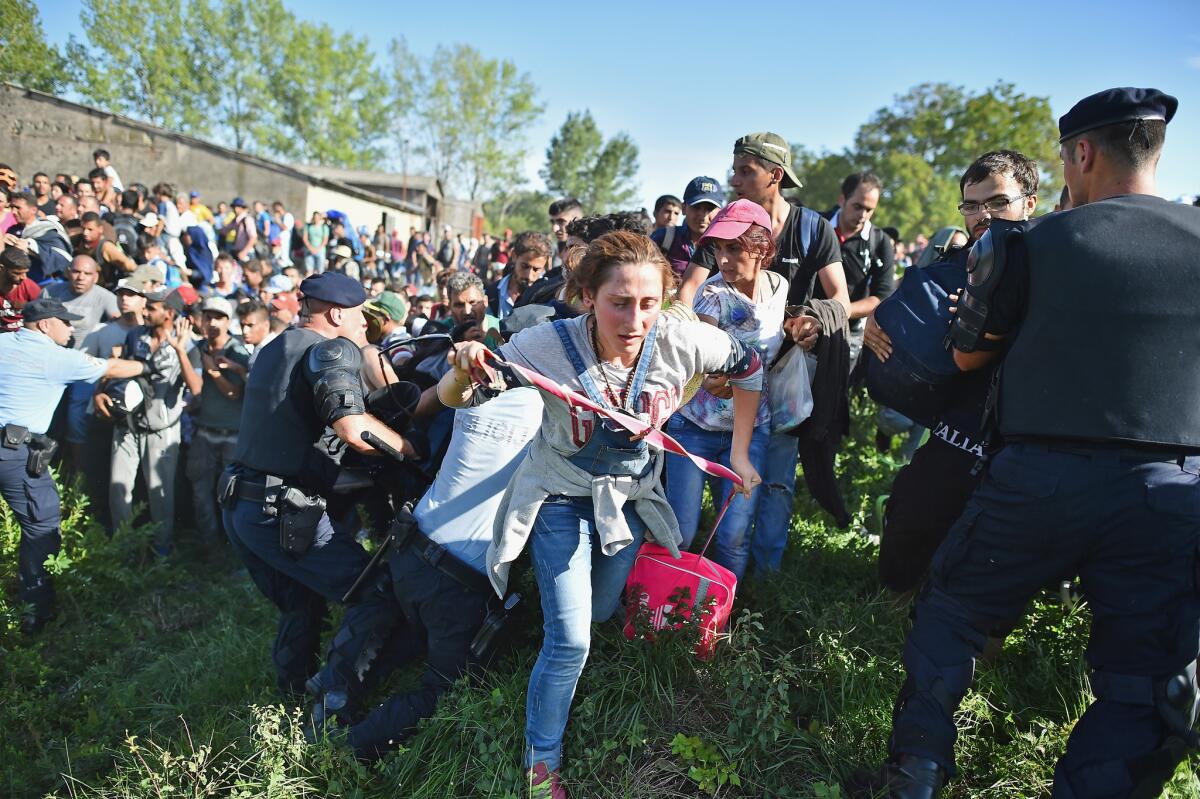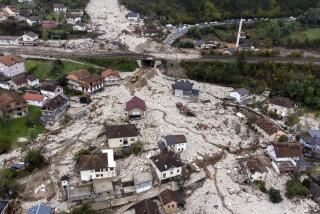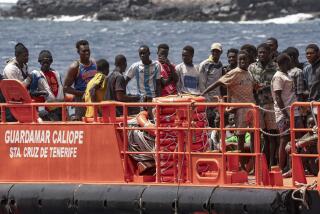Migrants, turned away by Hungary, inundate Croatia

Migrants force their way through police lines at the Tovarnik, Croatia, station to board a train bound for Zagreb, Croatia, on Thursday.
Reporting from Tovarnik, Croatia — A new pressure point built up along Europe’s migrant trail Thursday as Croatia found itself overwhelmed by thousands of asylum seekers heading north and said it could handle no more.
In less than 48 hours, the trickle of refugees who gave up trying to enter Hungary from Serbia and diverted to Croatia had become a flood. By late afternoon Thursday, nearly 9,000 people had crossed into Croatia, in some cases pushing past greatly outnumbered border guards deployed to regulate the flow.
There was no repeat of the violence seen at the Hungary-Serbia border Wednesday, when Hungarian riot police unleashed tear gas and water cannons on migrants trying to break through. But scenes were tense as migrants jostled to get through crossings from Serbia into Croatia under blazing sunshine, with temperatures nearing 100 degrees. Border police held back the crowds when they could.
“Croatia will not be able to receive any more people,” Interior Minister Ranko Ostojic told reporters at the train station in the border town of Tovarnik.
He did not say that the borders would be closed. But the military was ordered to stand ready to intervene if necessary, the Associated Press reported, citing Croatian media.
Confusion reigned over whether Croatian officials would allow migrants to journey through their country unimpeded or would try to register and process them as asylum seekers.
On Wednesday, the prime minister promised smooth and safe passage through Croatia, which virtually all the asylum seekers see as just a transit zone en route to Northern Europe. But Ostojic appeared to rescind that pledge Thursday, saying that neighboring countries such as Slovenia hadn’t yet agreed to let the migrants continue onward.
“If they want asylum, they can apply for asylum in Croatia,” Ostojic said. “We have to follow the rules. Croatia is under big pressure.”
That did not go down well with the migrants, thousands of whom jammed the railway station, crowding into every available patch of shade for relief from the punishing heat as they waited for trains or buses to take them deeper into Croatia.
Most want to go on to join relatives already living in countries such as Sweden and the Netherlands or to apply for sanctuary in Germany, which offers more generous benefits for refugees, has a stronger economy with more jobs and is preparing to take in as many as 800,000 newcomers.
“We don’t want to stay here,” said Ahmed Mazen, who had traveled from Baghdad with his 7-year-old daughter. “We left Iraq because there’s no future, and I’m searching for a future. I won’t find it here.”
Mustafa, a 25-year-old from the Iraqi city of Basra who declined to give his last name, agreed. “I didn’t come all this way to give my fingerprints in Croatia,” he said. “I spent a lot of time and money on this journey, and it was really difficult.”
Many of the refugees came to Croatia from the Hungarian border, where thousands had been stranded when Hungary closed the frontier. Others came directly from Serbia’s southern border with Macedonia.
The Serbian government organized buses, which migrants had to pay for, from both locations to the town of Sid, near the Croatian border. The migrants crossed the boundary on foot all day, walking along paths through corn and soybean fields, before police directed them to the train station.
Little food or water was available at the station, and the heat made the wait unbearable, particularly for the many families with children. Some men held up blankets to provide shade for their families.
By midafternoon, the migrants had cleared out of the station, some of them continuing their odyssey on foot.
The chaos in Croatia came as the president of the European Union, Donald Tusk, called an emergency summit for Wednesday of the leaders of all 28 EU countries. The EU has failed to come up with a unified response to the biggest mass movement of people in Europe since World War II, managing only to trade accusations over who is responsible for fanning the crisis.
The number of people crossing into Europe this year to flee war and poverty at home is edging close to half a million. More than 2,500 have died in the attempt.
Like a river, the asylum seekers have flowed along a well-carved route from Greece up through the Balkans and into Austria and Germany, branching off in other directions upon meeting obstacles.
After Hungary shut its southern border with Serbia this week and imposed criminal penalties on people sneaking across, migrants shifted westward. Croatian officials underestimated how quickly and in what volume the refugees would start funneling through their country.
Hungary, which has taken the toughest line against migrants, said diversion of the human tide away from its borders was exactly the result it had hoped for in cracking down. But its harsh tactics drew a sharp rebuke from Dimitris Avramopoulos, the EU’s commissioner for migration and home affairs.
“Hungary is not alone. These are also difficult times for your neighbors,” Avramopoulos said in Budapest, the Hungarian capital. “Passing … the refugees problem from one country to another is not a solution.”
Zeid Raad Hussein, the United Nations’ top human rights official, called Hungary’s use of tear gas and water cannons on asylum seekers “truly shocking.”
But the government in Budapest has refused to back down from or apologize for its actions. It contends that Hungary is defending the EU’s external borders.
Times staff writer Chu reported from London and special correspondent Chick from Tovarnik.
More to Read
Sign up for Essential California
The most important California stories and recommendations in your inbox every morning.
You may occasionally receive promotional content from the Los Angeles Times.











